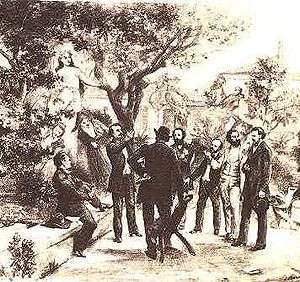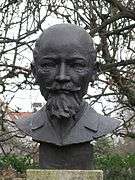Félibrige

The Félibrige (French pronunciation: [felibʁiʒ]; Lo Felibritge in classical Occitan, Lou Felibrige in Mistralian spelling, pronounced [lu feliˈβɾidʒe]) is a literary and cultural association founded by Frédéric Mistral and other Provençal writers to defend and promote Occitan languages and literature. However it is not to be confused with Occitanian organisations, as it defends cultural diversity within Southern France. It is presided over by a capolièr.
The word félibrige is derived from félibre, a Provençal word meaning pupil or follower.
Origins
.svg.png)
Le Félibrige was founded at the Château de Font-Ségugne (located in Châteauneuf-de-Gadagne, Vaucluse) on 21 May 1854 (Saint Estelle's day), by seven young Provençal poets: Théodore Aubanel, Jean Brunet, Paul Giéra, Anselme Mathieu, Frédéric Mistral, Joseph Roumanille and Alphonse Tavan. Together, they aimed to restore the Provençal language and codify its orthography.
Its symbol is a seven-pointed star which, as Frederic Mistral writes in Lou tresor dóu Felibrige, is "a tribute to its seven founders".[1]
They first applied themselves to the Provençal dialect of Occitan and the results of their efforts have been evident throughout Occitania since the end of the nineteenth century. Their presence can be discerned in Occitanian writers such as Michel Camélat and Simin Palav (Gascony and Béarn), Albert Arnavielle, Justin Bessou, Jacques and Gabriel Azaïs and Achille Mir (Languedoc), Arsène Vermenouze (Auvergne), Joseph Roux (Limousin), José Mange (Provence), and Charles Maurras.[2]
The Félibrige is an organisation focussed on protecting and promoting Occitan language and culture, fighting for recognition of cultural diversity both within France and across the wider world. It is also one of the two organisations represented across Occitania since 1945, along with the IEO.
Capouliérs
- 1876-1888 Frédéric Mistral
- 1888-1891 Joseph Roumanille
- 1891-1901 Félix Gras
- 1901-1909 Pierre Devoluy
- 1909-1919 Valère Bernard
- 1919-1922 Joseph Fallen
- 1922-1941 Marius Jouveau
- 1941-1956 Frédéric Mistral (nephew)
- 1956-1962 Charles Rostaing
- 1962-1971 Elie Bachas
- 1971-1982 René Jouveau
- 1982-1989 Paul Roux
- 1989-1992 Paul Pons
- 1992-2006 Pierre Fabre
- 2006-20?? Jacques Mouttet
Felebrigian festivals
There is a yearly meeting, which is called Santo Estello and held in a different town in the Pays d'Oc. The traditional banquet is ended with the ritual of the Copa Santa.
There are also other Fêtes Félibréennes:
- Since 1323, the Jeux floraux of Toulouse, considered as the model
- Jeux floraux of Barcelona
- Orange
- In 1868 at Saint-Rémy-de-Provence[3]
- In 1895 at Vic-en-Carladès, with a programme of music and dance (Cabrette)[4]
- In 1900 at the Château de Ventadour, under the name Fête de l'églantine
- In 1902 at Béziers
- In June 1903 and in 2009 at Sceaux
- In 1907 at Mauvezin, in the Hautes-Pyrénées[5]
- In August 1914, at Sauveterre-de-Béarn
- At Puy-en-Velay[6]
- In 1935 at Monistrol-sur-Loire
- Perhaps Argentat, after 1935 with the Chorale des gabariers de la Dordogne[7]
The Jardin des Félibres in Sceaux
In 1950 Sceaux, Hauts-de-Seine (one of the Parisien banlieu) was named Cité Félibréenne. A memorial garden for this event was created around the tomb of Jean-Pierre Claris de Florian, a French poet and romancier, well known for his fables and a noted Félibrigist (perhaps because his mother was Castilian). The garden displays eleven busts in all.
The garden is located behind the church of Saint Jean-Baptiste (Saint John the Baptist) in Sceaux. The entry, signed: Parc de Sceaux, Jardin des Félibres is located on Avenue du Président Franklin Roosevelt in Sceaux.




 Joseph Loubet
Joseph Loubet
 Pierre Deluns-Montaud
Pierre Deluns-Montaud
 Commemorative plaque
Commemorative plaque
Bibliography
- Eugène Lintilhac, Les Félibres, 1895, édition Alphonse Lemerre, in-12°, 136 p. Première partie - Félibres et Félibrige : L'énigme du Félibrige : les félibres de Paris, Cigaliers et félibres de Paris, le royaume poètique de Sainte-Estelle le capoulié Félix Gras, Un jour de printemps chez Mistral. Deuxième partie - Théodore Aubanel, La genése du Félibrige et Aubanel, le mouvement de Mistral, Jasmin, l'oeuvre d'Aubanel.
- La Plume, revue littéraire artistique et sociale, Paris, dir. Léon Deschamps, n° 53 du 1 juillet 1891, p. 213–237 du recueil annuel. (Numéro consacré au Félibrige à l’occasion de la mort de Joseph Roumanille)
- Émile Ripert, La Renaissance Provençale, Paris, Librairie Champion, 1918
- Émile Ripert, Le Félibrige, Armand Colin, 1924 ; réédition Éditions Jeanne Laffitte, 2001 ISBN 2-86276-363-2
- René Jouveau, Histoire du Félibrige (4 volumes), Imprimerie Bené, Nîmes, 1970–1979 ; réédition 1984-1987
- Valère Bernard, Bagatouni, rééd. Alandis Editions, 2000.
- Philippe Martel, Les Félibres et leur temps : Renaissance d'oc et opinion (1850-1914), Bordeaux, PUB, 2010
Notes and references
- ↑ Frederic Mistral, Lo tresor dóu Felibrige, vol. II, p. 887: Una estela a sèt rais es lo simbòl dau Felibritge, en memòria dei sèt felibres que lo fondèron a Font Segunha, a seven-pointed star is the symbol of the Félibrige, in memory of the seven félibres who founded it in Font-Ségugne
- ↑ Maurras fonde l' École parisienne du félibrige qui rompt avec les amis de Paul Mistral, voir Michel Winock, Le siècle des intellectuels, Seuil 1997
- ↑ Marcel Bonnet, « À propos des Fêtes Félibréennes de Saint Rémy en 1868: Zola contre Mistral », in Congrès de civilisation et de culture provençales. Éd. B. A. Taladoire. Avignon, Palais du Roure, 1961, pp. 31 38
- ↑ "Cabrettes et cabrettaïres (Auvergne) avec gravure dans le texte de cet instrument et de photos dans le texte de Vic Sur Cère et du concours de cabrettes de la ville aux fêtes félibréennes de 1895." Charles Mayet, in Le Magasin pittoresque, 1896, livraison n°13, pp. 209-224
- ↑ Une affiche est conservée au Musée d'Arles. Elle représente des instruments de musique: guitare, vielle, fifre-tambour et cornemuse.
- ↑ Les fêtes Félibréennes du Puy,slnd , in-12° , 148 p , 10 photographies hors-texte
- ↑ Fête son soixante-dixième anniversaire en 2005, avec la participation de L’École Ventadour de Tulle, La Bourrée Limousine de Brive, Les Vergnassous de St Germain Les Vergnes, Lou Gerbassous d’Ambazac, Les Pastourelles de Brive la Gaillarde, L’Eicola dau Barbichet de Limoges, L’Eiscola Dau Mont-Gargan de La Croisille-sur-Brillance, L’Églantino Dau Lémouzi de Limoges, Les Pastoureaux de la Valoine de Feytiat, Les Réveillés de Saintet-Fortunade, Les Amis de la Bourrée de Saint-Privat, Les Ranchos de Tulle
See also
- François-Juste-Marie Raynouard
- Occitan
- Provençal dialect
- Niçois
- Troubadour
- La Coupo Santo
- Le Jardin des Félibres in Sceaux
External links
| Wikimedia Commons has media related to Félibrige. |
- Félibrige
- History of Félibrige on NotreProvence.fr
- Felibrige sur lexilogos
- La Plume, n° 53 du 1 juillet 1891 (pdf) (cité supra dans la bibliographie)
- Conférence de Paul Ruat sur "le Félibrige", 8 février 1905.
- Lou Tresor dóu Felibrige online